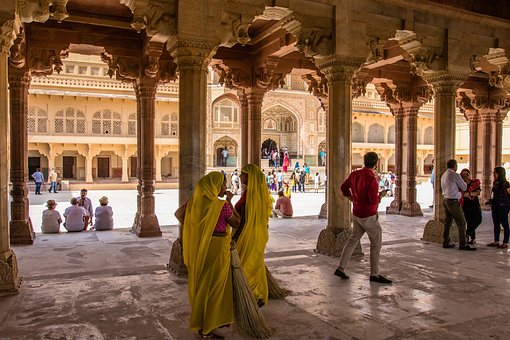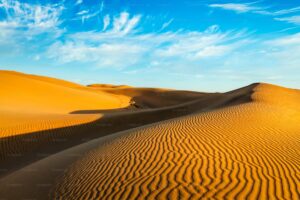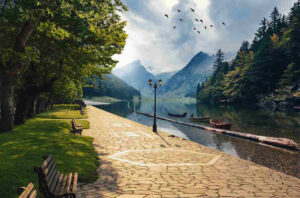10 best Rajput destinations in Rajasthan to visit with family
There are a large number of tourist destinations in Rajasthan which tell the story of the braveness and prosperity of this state, out of them some of the hottest places are listed below:
10 best Rajput destinations in Rajasthan to visit with family
1. The City Palace
Thereafter, the eminent Bengali Architect, Vidhyadhar Bhattacharya was assigned the work to establish this palace after keeping in view the rules of Vastushastra.
This palace is the symbol of prosperity to date because of the home of the Jaipur royal family and is always busy with traditional, cultural and religious events and also with a patron of arts, commerce and industry.
This palace complex is very vast and well-equipped with a large number of buildings, galleries, restaurants, courtyards and the Museum Trust offices.
Places of Attraction near City Palace:
- Mubarak Mahal
- Maharani Palace
- Chandra Mahal
- Jantar Mantar
- Amber Fort
- Hawa Mahal
- Birla Mandir
- Albert Hall Museum
- Nahargarh Fort
- Galta Ji
- Museum of Legacies
- Amrapali Museum
- Jal Mahal
Airport near City Palace: Jaipur International Airport is the nearest airport to this palace.
2. Jaisalmer Fort
Its architecture is so beautiful that its yellow sandstone walls are of lion colour in the day which converts into honey gold with sunset and due to the fact, this fort is famous as Golden Fort or Sonar Quila.
This fort is about 250 feet in height and has covered with about 30 feet long walls. Inspired by the culture and beauty of this fort the famous Indian film director Satyajit Ray a novel named Sonar Kella and later made a film on it.
Due to the story of this movie, a large number of visitors from Bengal and from all corners of the world visit this fort throughout the year to assess and experience the aspect of Satyajit Ray portrayed in the movie.
This Fort was included in the list of UNESCO World Heritage Sites along with five other forts of Rajasthan namely, Chittor Fort, Amber Fort, Gagron Gort, Ranthambore Fort and Kumbhalgarh Fort in the year 2013.
They were given the status of Rajput military hill architecture and serial cultural property. This fort is different from other forts of Rajasthan because it houses shops, museums, residential accommodations, restaurants and hotels.
Places of Attraction in Jaisalmer Fort:
- Jaisalmer Fort
- Jain Temples
- Desert Safari
- Gadisar Lake
- Kuldhara Village
- Tazia Tower and Badal Palace
- Sam Sand Dunes
- Patwon Ki Haveli
- Tanot Mata Temple
- Bada Bagh
- Akal Wood Fossil Park
- The Thar Heritage Museum
- Nathmal ki Haveli
- Salim Singh Ki Haveli
- Kuldhara
Airport near Jaisalmer Fort: The nearest airport to this fort is Jodhpur Airport which is about 270 km. from this fort.
Railway Station near Jaisalmer Fort: Jaisalmer Railway Station is connected with the nearby major cities railway stations and direct trains of Delhi, Jaipur and Jodhpur and can easily be reached at the fort by Auto, Rickshawas.
The Ideal Time to Visit Jaisalmer Fort: The Jaisalmer is nested in the Thar Desert so summer is too hot and dry and must be avoided whereas October to March is the ideal time to visit this place.
3. Pushkar

- Pushkar Lake
- Ananta Spa and Resorts
- The Westin Pushkar Resort
- Brahma’s Temple
- Aaram Bagh
- Pushkar Camel Fair
- Varaha Temple
- Jagat Palace
- Savitri Temple
- Rangji Temple
- Clarks Resorts
- Gurudwara Singh Sabha
- Gayatri Mata Temple
- Gau Ghat
- Varaha Ghat
- Man Mahal
- Naga Pahar
- Rose Garden
The attraction of this fort is the series of cobbled paths and gates and overlooks Maota Lake which supplies the water to the entire Amer Palace.
Several buildings made by Mughal architecture are built with red sandstone and marble. This fort along with Jaigarh Fort is situated in the Aravalli hills above the famous Cheel Ka Teela.
In medical time, the Amber was known as Dhundar and ruled by the Kachwahas from about 1037 to 1727 AE unit thereafter the capital Amer moved to Jaipur
The Amer town is now one of the heritage towns of the state and the source of boosting the economy of this town through a large number of tourists who visit here throughout the year from all parts of the world.
Places of Attraction near Amber Fort:
- Jaigarh Fort
- Jagat Shiromani Temple
- Nahargarh Fort
- Jal Mahal
- Panna Meena Ka Kund
- Sheesh Mahal
- Elefantastic
- Maota Lake
- Kesar Kyari
- States Kacheri
- Tunnel inside the fort
This Mahal is situated in Jaipur city, the capital of Rajasthan, in the northern part of India and is about a distance of 310 km. from Delhi.
The chief designer of this Mahal was Ustad Lal Chand and the main purpose of this design was to protect the ladies of the royal family.
This was only because the ladies of royal families had to follow the rule of Purdah by which they were not allowed to appear in public without hiding their faces with the covering.
In the summer season, the temperature of this place becomes very high and these windows and other architectural implements make it pleasant and cool.
The view of this mahal is very illusory as the people looking at it from the street think that its view is on the front side whereas, in reality, it is the backside of the mahal.
The maintenance and control of this mahal are in the hands of the archaeological department of the Rajasthan Government.
Places of Attraction near Hava Mahal:
- Hava Mahal
- Hava Mahal Museum
- City Palace
- Jantar Mantar
- Tripolia Gate
- Sawai Man Singh Town Hall
- Hidden Jaipur
- Jal Mahal
- Nahargarh Fort
- Albert Hall Museum
- Amber Palace
- Jaipur Elephant Ride
- Chandra Mahal
- Gaitor Ki Chhatriyan
The original name of this fort was Chitrakut. It is supposed that this fort was captured by the Guhila ruler Bappa Rawal but the other thought is that he got this fort in dowry.
According to historians the queen, Padmini was very beautiful and to get Padmini, the Delhi Sultanate ruler Alauddin Khalji invaded Chittor it is said that the queen along with other women committed suicide by Jauhar but this fact is not proven and different historians have their different views on it.
Thereafter the Chittor was assigned to Khizr Khan the son of Alauddin Khalji but administered and controlled by his slave Malik Shahin.
This fort is famous due to Maharana Pratap who fought with Akbar a large number of times but never gave up against his huge army unlike most of the rulers of Rajputana.
This is one of the main reasons that this fort is a famous point of attraction for tourists from all corners of the world.
The Rajput festival known as Jauhar Mela is organised by the Chittorgarh city and the fort annually in memory of all the brave women and queen Padmavati who did Jauhar to save their honour from others who defeated the Chittor.
Places of Attraction near Chittorgarh Fort:
- Rana Kumbha Palace
- Chittorgarh Fort
- Vijay Stambha
- Tower of Fame
- Fateh Prakash Palace
- Rani Padmini’s Palace
- Sanwariaji Temple
- Kalika Mate Temple
- Ratan Singh Palace
- Sathis Deori Temple
- Meera Temple
- Samadhisvara Temple
- Shyam Temple
- Gaumukh Reservoir
- Sita Mata Wildlife Sanctuary
- Bassi Wildlife Sanctuary
- Mandalgart Fort
- Gau Mukh Kund
- Maha Sati
- Kirti Stambh
Airport near Chittorgarh Fort: Maharana Pratap Airport and the Dabok Airport are the nearest airports to this fort.
Railway Station near Chittorgarh Fort: Chittorgarh Railway Station or the Chandeeriya Railway Station is the nearest railway station to this fort.
The Ideal Time to Visit Chittorgarh Fort: October to March is the ideal time to visit this fort. The Summer and Rainy seasons are suggested to be avoided due to heat and humidity.
7. Ranthambore Fort
It is supposed to be built by the Chahamanas also known as Chauhans and was captured by the king of Delhi in nearly the 13th century.
This is located in the Asia and Pacific Region and is one of the Hill Forts of Rajasthan spread over 101 hectares. This fort is also recorded as a UNESCO World Heritage Site during the year 2013.
It is not certain who built this fort because of different opinions by the historians as one belief is that it was constructed by the Rajput ruler Sapaldaksha and the other is that it was constructed during the reign of King Jayant.
This fort remained under the control of Rajput kings of Mewar named Rana Kumba and Rana Sanga.
There are three Hindu temples inside the fort dedicated to the God Shiva, Ganesha and Krishna which were constructed with a red stone of Karauli in about the 12th and 13th centuries.
The Lord Sumatinath who was the 5th Tirthankar of Jain and Lord Sambhavanath is also located in the complex of this fort.
The fort is divided into two divisions and several temples and holy Stambhas are situated in the western part and the Eastern area is left as the wild area where a large number of wild animals and birds can be seen which makes this place one of the most famous tourist attraction all around the year.
The importance of this palace is added by the centre of the trade route between north and central India and therefore, was the best choice of the rulers of the North.
Places of Attraction near Ranthambore Fort:
- Ranthambore National Park
- The Tigress Spa and Resort
- Ranthambore Fort
- Ranthambore National Resort
- Surwal Lake
- Malik Talao
- Trinetra Ganesha Temple
- Raj Bagh Jungle Resort
- Raj Bagh Lakh
- Padam Lakh
- Kachina Valley
- Dastkar Ranthambore
- Jogi Mahal
- Ranthambore School of Art
- Wild Dragon Adventure Park
- Raj Bagh Ruins
- Jeep Safari Ranthambore
- Tiger Reserve
Airport near Ranthambore Fort: Sanganer Airport is the nearest airport and is located in Jaipur city.
Railway Station near Ranthambore Fort: Sawai Madhopur Railway Station is the nearest railway station to this fort and is located about 11 kilometres distance.
The Ideal Time to Visit Ranthambore Fort: The ideal time to visit is from October to March though the wildlife destination remains open from October to June.
8. Umaid Bhawan Palace
This palace came into existence from the vision of Maharaja Umaid Singh to build the largest private residence in the world.
The present owner of the palace is Gaj Singh descendant of Maharaja Umaid Singh of the Rathore Dynasty who gave the name to this palace and some part of this palace is managed and controlled by the Taj Group of Hotels.
This palace gives the true royal experience because of its architectural splendour and the unique heritage hotel of Jodhpur.
This palace was meant for the residence of the former royal family of Jodhpur which consists of about 274 rooms. The beauty of this palace appears to be the magnificent crown of the desert city.
This place is the last royal palace constructed before India’s independence.
Its construction took the time of about 15 years from 1928 to 1943 and the architects of this palace were Budhmal Rai and Sir Samuel Swinton Jacob who mainly used golden yellow or dun-coloured sandstone to make it an eye-catching structure.
This palace has three divisions used for the residence of the royal family, a museum based on the lifestyle and history of the Royal Family of Jodhpur and a unique Taj Palace Hotel. Out of the total area of about 25 acres, about 15 acres are allotted for beautiful gardens.
The museum of the palace mainly exhibits stuffed leopards, Queen Victoria gave Maharaja Jaswant Singh a large symbolic flag in the year 1877, lighthouse shapes. In the garden, in front of the museum, the classic cars of the Maharajas are displayed.
Places of Attraction near Umaid Bhawan Palace:
- Umed Garden
- Ramdevra Temple
- Ganesh Temple
- Mehrangarh Fort
- Phool Mandir
- Umaid Heritage Art School
- Santoshi Mata Temple
- Kotsa
- JaipurMagic Day Tour
- Ali Baba House
- Blue Bohemian
- Jodhpur Camel Safari
- Dilwara Jain Temple
- Peace Park
- Machiya Safari Park
- Umed Garden Zoo
Airports near Umaid Bhawan Palace: Jodhpur Airport (4 km.), Maharana Pratap Airport, Udaipur (126 Km.), and Jaipur International Airport (175 km.) are the nearest airports to this palace.
Railway Station near Umaid Bhawan Palace: Jodhpur Railway Station is the nearest railway station to this palace and is well connected with the major cities.
9. Ranthambhore National Park
Situated in the Sawai Madhopur district Ranthambore National Park is a part of Rajasthan State of India and covers an area of approx. 13,35,000 meters.
This national park originated in 1980. Before its announcement as a national park in 1980, it was announced as Project Tiger Reserve in the year 1973.
In 1984 the areas of this place were attached to the nearby forests and were declared with the name Sawai Man Singh Sanctuary and Keladevi Sanctuary.
The Tiger Reserve was further enlarged by merging the Keladevi Sanctuary and the Sawai Mansingh Sanctuary on the north and south sides respectively of this sanctuary along with other adjoining forests.
This flora is spread all over the place here and consists of nearly 542 species of flowering plants.
The Ranthambhore national park is the home of dry forests and harbours open grassy meadows.
A large species of fauna like the nilgai, Indian leopard, sambar, wild boar, Bengal tiger, plain grey langur, mugger crocodile, striped hyena, sloth bear, rhesus, macaque, and chital are the main strengths and attractions of the park.
A large number of banyan trees are found in this place. Earlier, this national park was known for the largest tiger population which was with time decreased because of poaching and other reasons.
According to an estimate the recorded number of tigers in Ranthambhore National Park was about 44 to 45 in 1982 which reduced to 26 to 27 tigers in 2005.
The government of India in coordination with the state government and forest officers made all the possible efforts to eliminate poaching and so the number of adult tigers reached 34 and of cubs 14.
This figure is derived from the survey by non-governmental sources. This all was due to the effective steps taken by the state government, NGOs and the local villagers by stopping the killing of tigers and installing surveillance cameras at different places in this national park.
Places of Attraction near Ranthambhore National Park:
- Ranthambhore National Park
- Surwal Lake
- Ranthambhore Fort
- Trinetra Ganesha Temple
- Ranthambore Tiger Reserve
- Wildlife Safari
- Malik Talao
- Raja Bagh Talao
- Padam Talao
- Kachida Valley
- Dastkar Ranthambore
- Jogi Mahal
- Raj Bagh Ruins
- Dastkar Ranthambore
- Ranthambore School of Art
- Lakarda and Anantapur
- Bakula Region
- Akaula Region
The nearest Airport to Ranthambhore National Park: The nearest airport is Sanganer Airport located nearly 182 km.
The nearest Railway Station to Ranthambhore National Park: The nearest railway station to this park is Sawai Madhopur located nearly 12 km.
The Ideal Time to Visit Ranthambhore National Park: The ideal time to visit is before the rain which is from April to June though the weather at this time is very hot the animals could be watched in the open at this time. January to March is comparably more comfortable.
The Ideal Time to Visit Umaid Bhawan Palace: The ideal time to visit this Palace is between October to March. The Summer and the Raily seasons are very dry and humid and should be avoided.
10. Sariska Tiger Reserve
- Sariska National Park
- Kandwadi Fort
- Kesroli Hill Fort
- Sariska Palace
- Neelkhant Temple
- Stargate Observatory
- Silliserh Lake
- Naldeshwar Temple
- Viratnagar
- Bhangarh Fort
- Bhartrihari Nath Temple
- Pandupol Hanumanji Temple













